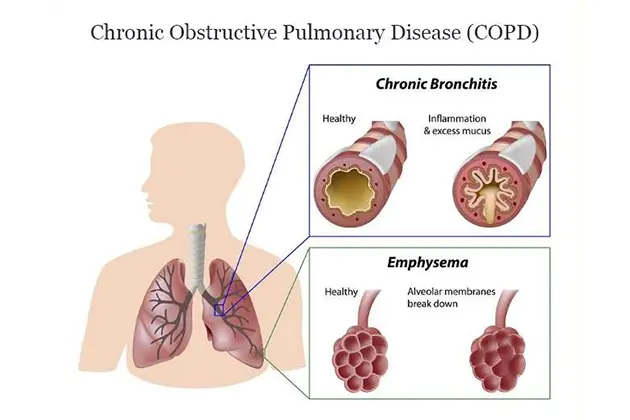The smallest things, going up the stairs and going for a stroll, can feel like insurmountable tasks for those who live with Chronic Obstructive Pulmonary Disease (COPD).
With its capacity to repair damage and calm symptoms, stem cell therapy is offering a solution.
This blog dives into the science of this revolutionary therapy and how stem cells can help manage the COPD stages, providing long-term relief for patients.
An Overview of COPD: Key Causes, Symptoms, and Challenges
COPD can strike from the environment around you. While smoking gets most of the blame for lung damage, it’s not the only villain. Invisible enemies like polluted air, chemical fumes, and fine dust particles can slowly cause the kind of harm that leads to COPD. And for some, a genetic trait like alpha-1 antitrypsin deficiency can raise the odds.
The issue with current treatments is that they fail to repair the damage caused at each COPD symptom stage. Without repairing the damage, the disease marches on, and the struggle for breath never stops.
Image source: startstemcells.com
What is Stem Cell Therapy?
In stem cell treatment for COPD, stem cells are introduced into the body to regenerate diseased lung tissue and improve overall respiratory health.
What makes these cells so transformative in healthcare? Because they can transform into different types of cells. That’s what makes them so powerful for healing injuries or repairing organs.
And the possibilities? They’re huge.
Think of joint pain, autoimmune issues, or COPD. Stem cell therapy is paving the way for new approaches to tackling tough health conditions.
Let’s break down the key types of stem cells that make it all happen:
| Type of Cell | Source |
| Embryonic Stem Cells | Taken from early-stage embryos (blastocysts) |
| Adult Stem Cells (e.g., Mesenchymal Stem Cells or MSCs) | Harvested from tissues like bone marrow, fat, or blood |
| Induced Pluripotent Stem Cells (iPSCs) | Created by reprogramming adult cells, such as skin or blood cells |
How Stem Cell Therapy Can Transform COPD Care
Duke University researchers have uncovered a unique advantage of mesenchymal stem cells (MSCs) for patients across different COPD stages. These cells not only reduce inflammation but leave behind powerful, long-term therapeutic effects after they’ve left the body.
This breakthrough opens up possibilities for:
- Extended Symptom Control: MSCs offer prolonged inflammation relief, leading to more stable health.
- Lung Regeneration: They assist in repairing damaged lung tissues, which could restore function.
- Fewer Emergency Visits: By stabilizing immune responses, MSCs may prevent flare-ups, reducing hospital trips for COPD patients.
The Process of Stem Cell Therapy for COPD
There are two main methods for delivering stem cells for COPD treatment: IV or directly into the lungs. Both methods have shown safety in clinical trials, but their effectiveness depends on factors like disease stage and the patient’s overall health.
The process begins with patient evaluation, followed by stem cell harvesting (if using autologous cells), lab processing, and administration. Each step is tailored to the individual, aiming to optimize the cells’ regenerative effects on damaged lung tissue.
Each patient’s recovery time may differ, but noticeable progress is often seen within weeks or months on average.
Key Considerations When Choosing Stem Cell Therapy for COPD
Stem cell therapy offers groundbreaking possibilities, but the risks and limitations demand closer scrutiny:
Safety Concerns and Risks
While stem cell therapy opens new doors in medicine, infections during harvesting or injection are potential risks that must be managed with advanced safety protocols.
Another concern is that your immune system might see the introduced cells as foreign and attack them, reducing their effectiveness. This is why precise techniques and close monitoring are critical throughout the treatment.
Regulatory Challenges
Stem cell therapies for COPD remain experimental in many countries. The FDA and EMA have yet to grant full regulatory approval, meaning patients often turn to clinical trials or seek treatment abroad, where safety standards may differ.
Cost Implications
Costing between $10,000 and $20,000, stem cell therapy places relief out of reach for many living with COPD. This cost emphasizes the need for better insurance coverage and more affordable treatment solutions.
Ethical and Research Considerations
The ethical implications of using embryonic stem cells in treatments are undeniable, prompting researchers to explore whether MSCs can offer similar regenerative benefits for COPD patients. For now, a cautious approach emphasizes patient safety and ongoing data collection.
In Conclusion
Stem cell therapy presents a promising approach for managing COPD, with the potential to address COPD symptoms stage by stage–potentially reducing inflammation, regenerating lung tissue, and lessening hospitalizations. These benefits could revolutionize COPD care, giving patients new hope for relief and independence.
At Swiss Medica, we offer an ethical, science-backed solution using adult mesenchymal stem cells to enhance COPD care.
What are your thoughts on stem cell therapy for COPD? Join the conversation in the comments below!











